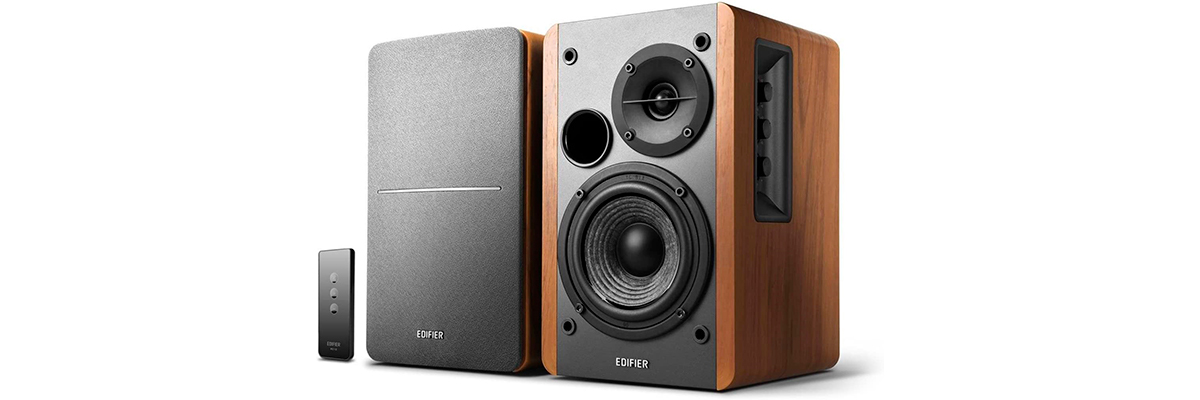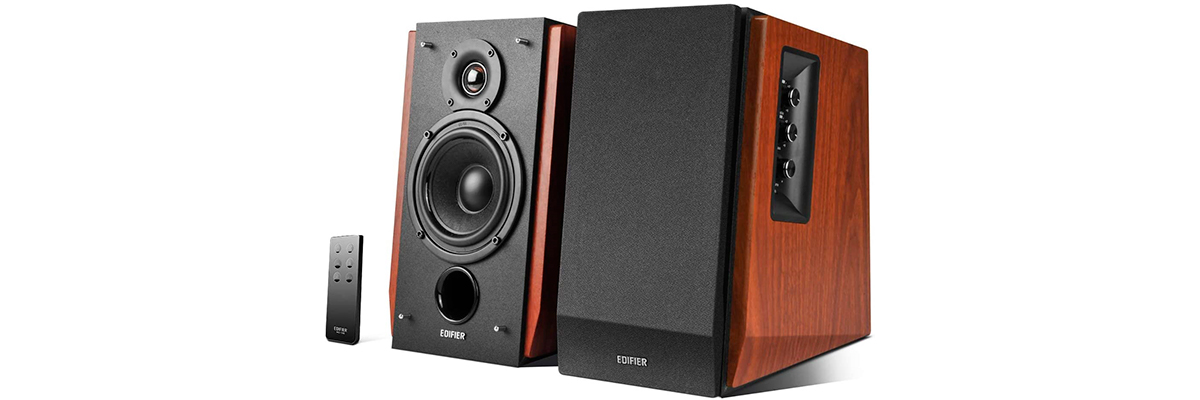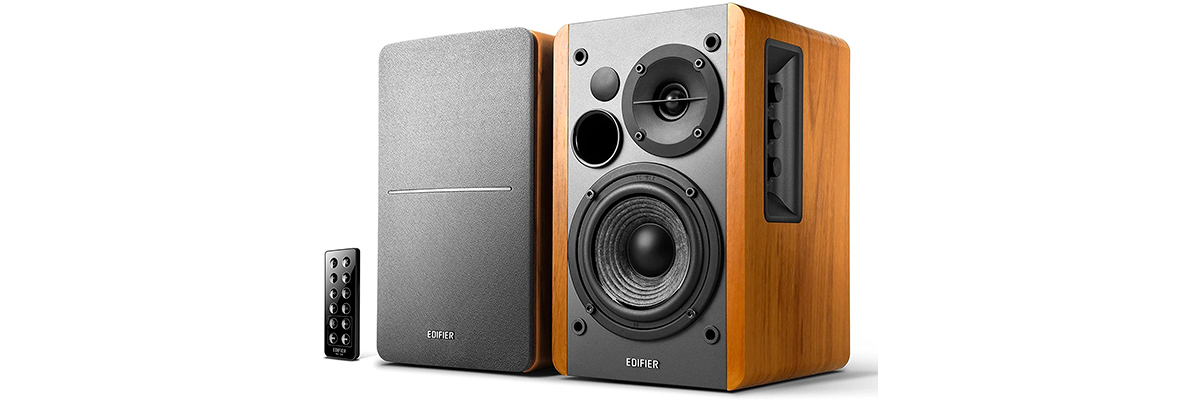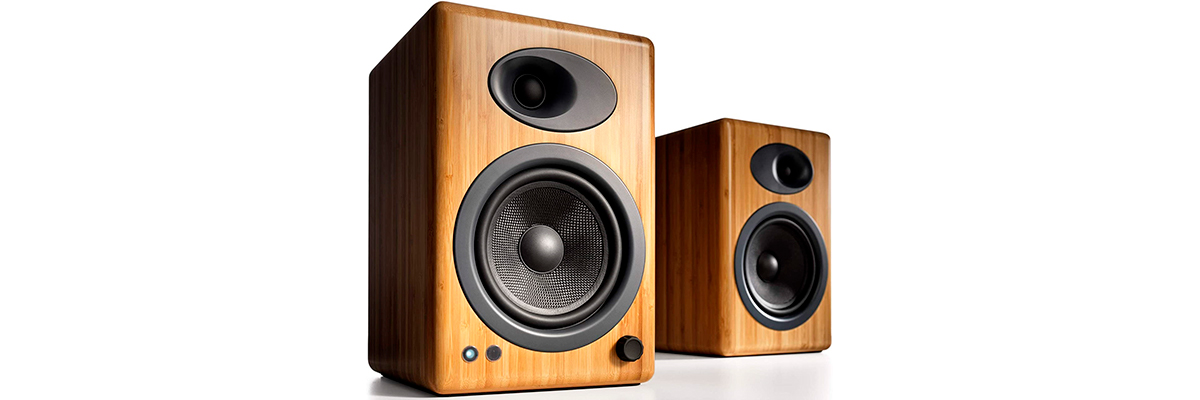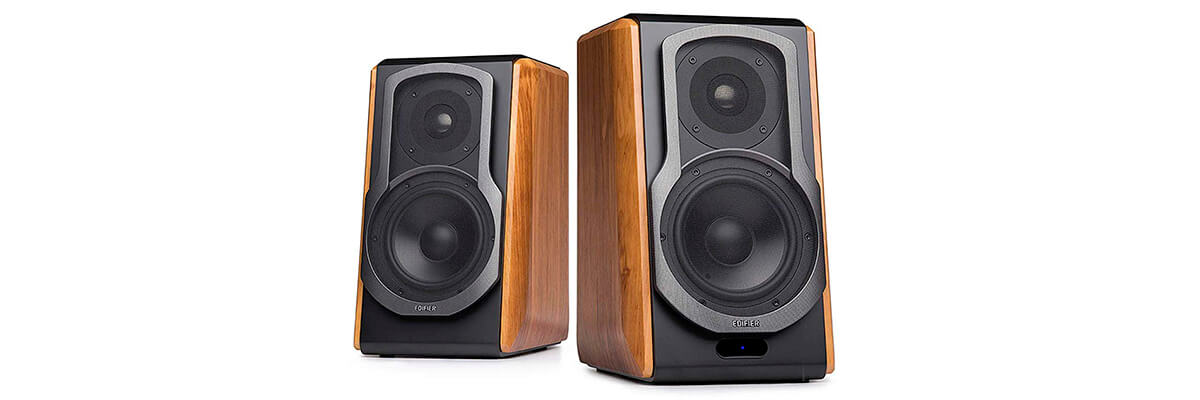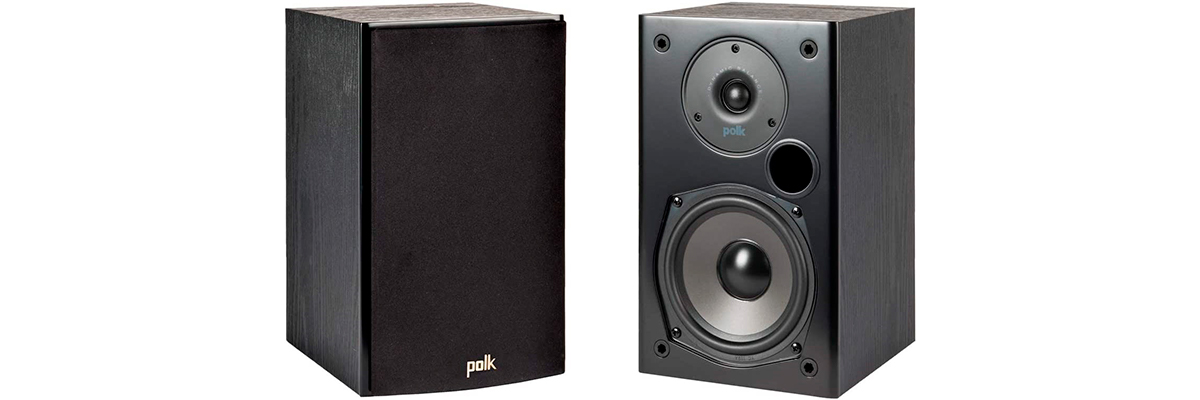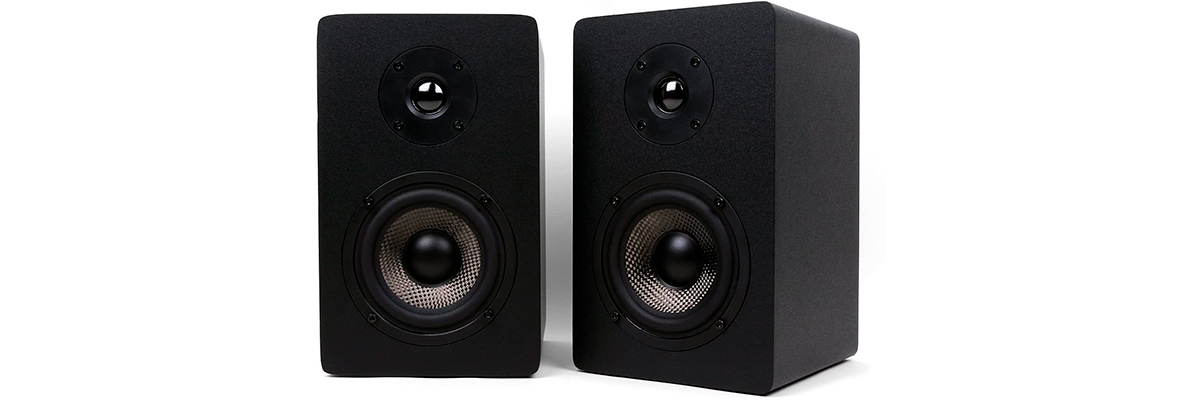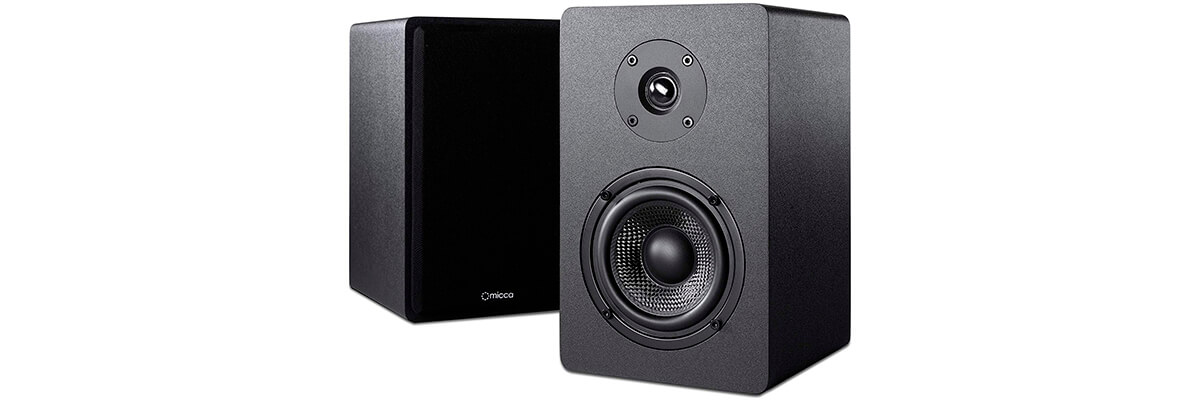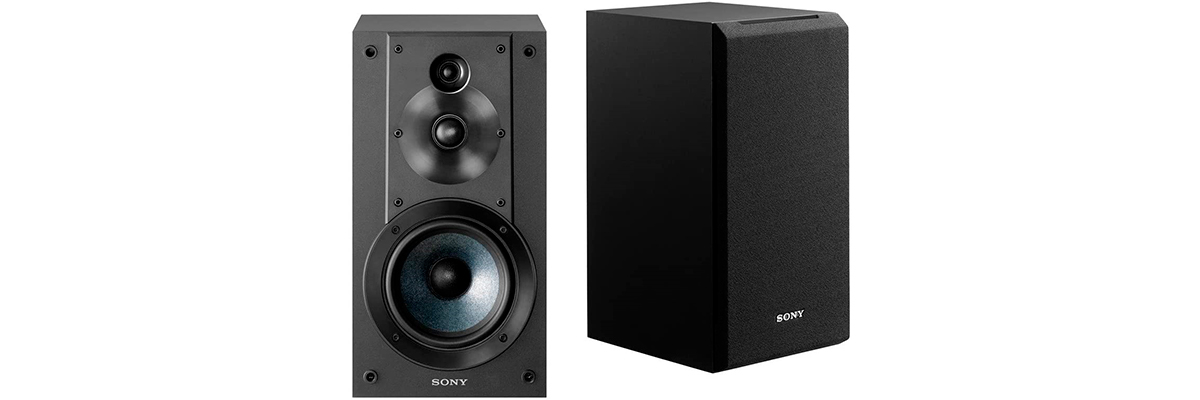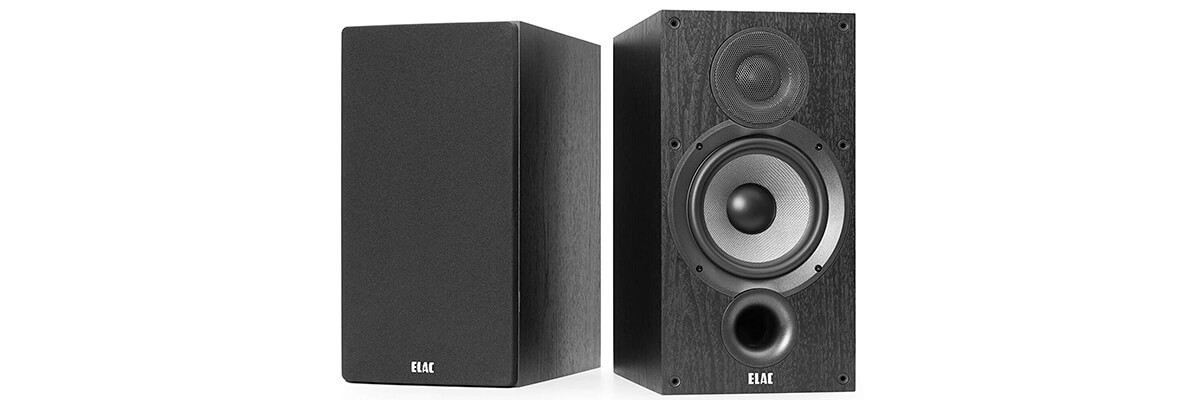How to Choose the Speakers You Need
Even a very pricey turntable can’t produce the most high-quality sound from integrated speakers. That is why perfect playback of your favorite vinyl records requires the right external speakers. Moreover, even if you have a record player of mediocre quality, you can easily fix its sounding by buying the best speakers for vinyl. They should combine a classic look and a modern sense of audio quality to ensure the true-to-originally-recorded sound of both old and new LPs.
Our top includes passive and active, bookshelf and floor standing, expensive, and budget-friendly models. So don’t delay reading our article if you want to provide your vinyl sound system with authentic sound.
Best Speakers for Turntable Reviews
Best Bookshelf Speakers for Vinyl
The bookshelf speakers are usually active type; however, the passive models are also presented in the market. I’ve chosen the best speakers for record player in each category.
Active Bookshelf Speakers for Vinyl
Edifier R1280T — Best Powered Speakers for Turntable
This 2.0 sound system can be considered as the best speakers for vinyl record player in terms of versatility. As it doesn’t matter what you are listening to, they provide crisp highs and mids with any audio content. The integrated silk-dome tweeter and 4-inch woofer provide close to studio-quality sound reproduction. The built-in amp has 21W of power per channel. Some distortion can be heard if you fully turn the bass knob up. Nevertheless, the bass reproduction is still rich and robust which results in a well-emphasized sounding of percussion instruments.
These budget active speakers can’t provide wireless connectivity options, but they offer output for headphones and dual RCA output. The integrated control knobs allow adjusting the audio reproduction from warm to lively and dynamic. They also come with a minimalistic remote control which allows you to regulate the volume or mute them. The speakers have classy look with a wood-like finish on the sides and a metallic finish on top.
Pros
- The overall sound is bright and balanced.
- The sound is volumetric enough to provide the effect of presence.
- The frequency response is even.
Cons
- The included cables are of poor quality.
- The bass can’t go deep.
Edifier R1700BT
These powered speakers for turntable are powerful enough to provide decent playback as they have 132W of max output power. The dome tweeter ensures clear and transparent highs. Rich bass reproduction and well-emphasized low frequencies are provided by a 4-inch bass driver. These drivers are placed very close to each other, giving a more spatial soundstage with clear instruments and vocals. The overall sound reproduction can be characterized as warm. It’s hard to catch any sound distortion since the speakers feature built-in DSP and DRC. You can adjust the sound in accordance with the music style thanks to 3 side-mounted control knobs.
Except for 2 AUX inputs, they also offer wireless connectivity via Bluetooth which, however, can’t be disabled: it’s always in a pairing mode. The housing of the speakers has a classic vintage look and is made of high-quality 12-mm thick MDF, so they will probably become a great compliment to your turntable setup. Thanks to such a construction, the speakers have superior acoustics and resonate less.
Pros
- This model has a balanced performance.
- The quality of sound maintains across all music genres.
- They can get really loud and fill the mid-sized room with sound.
Cons
- There is no password or security for Bluetooth.
- The Edifier R1700BT can’t provide a highly detailed sound.
- They require an external subwoofer for better sound depth.
Edifier R1280DB
The Edifier R1280DB offer great audio clarity. Both female and male voices are clearly hearable since the sound reproduction is free from distortion. The mids are really detailed and balanced with highs. These speakers are reasonably powerful having 43W of total output power. Generally, they have a warm tone which makes them well-suited for a wide array of music styles. Nevertheless, they lack a bit in terms of bass reproduction which may be frustrating for rock music lovers. The Edifier R1280DB can possibly work as the best powered speakers for vinyl for those who have a lot of old LPs as they aren’t demanding for the quality of the recording.
These mid-class active speakers feature Bluetooth wireless connectivity which works flawlessly without sound quality loss. There are 3 control knobs that you can use to adjust the EQ in accordance with your preferences. These speakers have durable construction owning a solid MDF case with a light wood finish and have rounded corners. The drivers are covered by removable fabric grilles.
Pros
- The sensitivity of 85dB makes the sound clean.
- The volume button additionally serves for input switching.
- The kit includes all cables for a lot of connection options.
Cons
- For some reason, the power indicator is located on the rear of the speaker so you can’t see it.
- They cannot deliver a very loud sound.
Audioengine A5+
These speakers for vinyl player are among the most powerful ones when it comes to bookshelf models as they have an incredible 150W of total power. These premium-quality speakers work great for high-fidelity audio and can be a true blessing for audiophiles. The clarity and depth of sound across all the frequency range are truly impressive. The bass is not overwhelming but will probably be enough for most users. Generally, the A5+ provide natural and realistic sound which is vital for both digital and analog record players. Thus, they are really good speakers for vinyl and can be used with turntables that have or don’t have an integrated preamp. However, there are no knobs or buttons to tune the sound which may be a problem for some users.
These speakers have inputs for headphones, subwoofer, stereo mini jack, USB, and RCA inputs. They are also Bluetooth-capable. These speakers come grille-free, with hand-crafted cabinets that have a glossy wood finish of a light shade. Each speaker packs an aramid fiber woofer and silk tweeter. The bottom is made of foam rubber to ensure stability on any surface. The rear panel includes a Bluetooth antenna that can be moved left/right for a better signal. The included aluminum remote gives you control over the volume level.
Pros
- All the connectors are gold-plated.
- Their sound can be characterized as rich and full.
- They are equipped with a very powerful dual class AB monolithic amp.
Cons
- Some humming sound at top volume levels is noticeable.
- Can be overheated at some point and shut down as a result.
Edifier S1000DB
The simple yet solid design of this active acoustic system and the powerful built-in amplifier would make them the best speakers for vinyl record player of the middle segment. The total output makes an overwhelming 120W. The woofer is put at an angle for a steadier and distortion-free sound. The tiny-cellular grill prevents the audio from “tail dropping” while creating no resonance. Metallic cones produce the sharper digital audio; yet, the sound lacks the warmness a bit at the turntable playback. However, the natural wood case is perfect for silencing the interference and supporting the bass. The latter is powerful and clean, with a wide frequency specter. The highs are clean and transparent, the midrange provides a clear central line. However, for the optimal work of the crossover, it is necessary to put the active speakers for turntable at a distance of at least 10 feet and a bit below the ear level.
Pros
- The natural sound without coloring.
- I connected multiple sources including a phono stage, AV receiver, and headphones through the dedicated ports.
- Handy remote control with the active interface indication.
Cons
- Heavyweight.
Passive Bookshelf Speakers for Vinyl
Polk Audio T15 — Best Speaker for Vinyl
The present 2-way speakers incorporate a 5.25-inch woofer which is responsible for providing volumetric and immersive sound with a well-balanced soundstage. The low frequencies are well-distinguishable and have massive bass reproduction. The 0.75-inch silk dome tweeter is precise and provides bright trebles. The Polk Audio T15 can potentially be the best speakers for vinyl record player when it comes to sound clarity thanks to Polk’s proprietary Dynamic Balance technology. It provides a well-calibrated sound and works great in splitting the sound frequencies. They also have a decent max output power of 100W and a reasonable sensitivity of 89 dB. The level of sound distortion is low.
The speakers come with two cloth grilles, but, to my mind, they sound better with grilles off.
The outer carcass is made of thick MDF which minimizes resonance. On the rear panel, you will see two 5-way binding posts. These small passive speakers are only 7-inch deep and 10-inch wide so they will easily find a place on most desktops. Notwithstanding, they are still capable of filling a small or mid-sized room with sound.
Pros
- There is a special keyhole slot for a wall mount.
- All the vocals are clearly hearable.
- The sound clarity of 24000Hz will ensure high-performance audio reproduction even with poorly recorded vinyl.
Cons
- Bass becomes weaker at low volume levels.
- They lack a bit in terms of sound fullness.
Micca MB42X — Best Budget Speaker for Turntable
The Micca MB42X can be considered as good speakers for turntable thanks to a highly-optimized 18 dB crossover which accurately distributes instrumental channels.
The 4-inch woofer, made of woven carbon fiber, provides an impressively powerful bass with well-separated low frequencies. Ported enclosure contributed to more extended bass performance. The highs appear to be clear and transparent thanks to the silk dome tweeter.
These drivers give the speakers a truly three-dimensional sound. Thanks to that, you can hear all the vocals, claps, whistles as they aren’t suppressed by other sounds. These speakers have a power handling of 75W at an impedance of 4 to 8 Ohms. They will work well for small spaces.
The cabinet is too lightweight, so they resonate at high volumes. Although this problem can be easily solved if you put something on top of each speaker (book, for example). The low frequencies can’t be called stable as there are some hearable bursts and dips. These speakers for record player are fairly well made, having classic contours and a black matte finish which feels silky-smooth to touch. They come with magnetic grilles that can be effortlessly attached and detached. However, It seems to me that the sound is cleaner with the grilles on.
Pros
- They have a really natural sounding.
- The bass response of these speakers will likely outperform many larger models.
- They are pretty loud as for their size.
Cons
- Some rattling can be heard at top volume levels.
- The provided manual is very basic — there is no visual representation of how to hook up the speakers.
Micca PB42X
These speakers supply everything the regular listener needs. The 15W per channel enables decent sound reaching over 100 dB. The bottom bass sounds nice, with enough power and presence effect, though, at top volume, bumps like “music in the head”. The crossover is not impressive at voice sound, while instrumental channels are distributed accurately. The woofer works nicely, while the tweeter produces an unstable impression at high volume. The setup is standard for the speakers with RCA input, all the ports are labeled correctly and feel sturdy enough. Another great bonus is the built-in DSP allowing using the speakers for PC and smartphone audio. Considering the bottom price, the midrange should be a fraction more steady.
Pros
- Warmness and mellowness for both analog and digital sound.
- I adjusted the frequency response via the equalizer and got a cleaner soundstage.
- The sleek design of the cabinet and component.
Cons
- The lightweight build features resonance at top volume.
Sony SSCS5
These 3-way passive speakers provide a high-res audio reproduction. They have 100W of peak output power, feature two tweeters, and a 5.12-inch woofer. Together, they expand the soundstage and provide close-to-original sound performance. The highs are so precise that you can literally feel the positioning of instruments. The woofer provides a dynamic sound, with enhanced low-end frequencies with deep and stable bass, so it’s not necessary to pair them with a powerful sub. Thanks to 3 drivers, these speakers are able to provide good instrument separation which is especially important listening to vinyl records.
Unlike the other budget models, the Sony speakers don’t use cheap paper cones that tend to distort the sound and can’t ensure longevity. Instead, they use MRC cones that hold their shape for years even despite high pressure and speed, so you can listen to bass-heavy music without sound quality deterioration. Each speaker has a nice, all-black finish and looks minimalist. The whole enclosure is made of wood which damps unwanted vibrations, improving the playback quality. There are two ports on the back.
Pros
- The MRC cones help enhance bass reproduction.
- Having low, 6-Ohm impedance, these speakers are able to provide rich acoustics.
- They provide accurate sound reproduction even at high volume levels.
Cons
- Higher frequencies are not so detailed.
- An appropriate amplification to provide high-quality audio is needed.
- The mid-range is a little bit dry.
KEF LS50
The elegant non-standard shape and solid future-proof build of all the components make this externally-powered acoustic system the best speakers for record player, wouldn’t they cost a whole media system of the middle class. Thick walls keep the sound resonance-free and let them produce a super-powerful output. The 100W power lets out up to 106 dB that sound pristine within the whole spectrum. The woofer is wrapped into the special damper that together with the bent shape of the speaker decreases the vibration and enables the steady confident bass. The midrange radiates the dense audio flow and the uniform central line. The crossover serves for the precise channel distribution making each frequency distinct while in-line with the general sound flow. The vinyl sounds warm, rich, and natural, relaying all the particulars of the record. Both digital and analog audio are detailed and dynamic.
Pros
- These passive speakers have a well-balanced vast soundstage.
- Precise and rich sound with no coloration.
- Solid enforced connectors.
Cons
- A low-to-mid sensitivity requires a powerful amplifier.
- No dust grills for external protection.
Klipsch R-14M
These compact passive speakers might be called the best bookshelf speakers for vinyl, be there more options in their interface. Yet, they fit into any setup, from PC desk to phono stage, filling a relatively small room with a deep and detailed sound. The crossover and drivers work precisely, enabling the low-frequency cut and super distinct middle line. The high-quality components serve for the perfectly clean audio, even through the low-end amplifier. Good output and wide soundstage with next to no interference at extreme volumes. The sound is precise within the whole range, though it might seem a bit too bright on highs. They produce a powerful bass, impressive and responsive, with a solid thump. Still, their range does not go below, to the sub-bass. Plugging in these speakers is straightforward, the onset of inputs is clear and the connection ports are solid enough.
Pros
- Flowing and velvety analog playback.
- I paired them with the AV receiver and tuned up the EQ to my taste.
- The magnetic grill can be easily detached.
Cons
- The overly bright blue indicator is distracting.
Elac Debut 2.0 B6.2
TThis passive acoustic system produces a highly dynamic and vivid sound. The soundstage is wide and transparent, conveying all the nuances of the analog sound. The lows are rich and confident, though not bottom-reaching. They translate the reverberations accurately, without the slightest distortion. The enhanced build including the inner bracing of the construction and the solid multi-directional crossover emanate clear and colorful sound within the whole spectrum. These good speakers for record player create a three-dimensional picture even of the poorly recorded vinyl. I listened to some 1950s’ records out of my collection and the mids sounded well, though a bit muffled. However, the tonality, in general, was very warm and precise. Paired with a less powerful amplifier, they produce much thinner sound, providing audible interference at the volume increase. Considering the price range, they may have an amp issue. The latter must be highly powerful to match these speakers.
Pros
- The silk dome tweeter produces confident clean highs.
- Nice classic design.
- The front reflex port allows placing the speakers near the wall.
Cons
- Rather large for this category of speakers.
Fluance Signature HFS
These small passive speakers fill the room with sound that is both loud and clear. The tweeter produces tailor-cut highs, as accurate as can be, while the bass is strong and immersive. They create a deep colorful soundstage, with all the nuances distinctly heard. The sound is precise and authentic. For the sonic factor, they would get the deserved best speakers for vinyl record player award, while the analog warmth seems to fade away with the volume increase. In general, the sound flows seamlessly, there is no interference even at the sharp transitions, thanks to the solid work of the crossover. These speakers can also make decent fronts in any surround system, as they deliver nice warm digital audio as well. The processor works fast with all formats. The wood design of cabinets silences all the interference, enabling the super clear sound. Setting up these speakers is easy, the connection ports are standard and easily spotted.
Pros
- Clean and powerful, sharply outlined vocals.
- A wide spectrum of sound even at the top volume.
- Stylish design.
Cons
- Small drivers do not allow the bottom-deep bass.
- Well-printed, comprehensive manual.
Floor Standing Speakers for Vinyl
The floor standing speakers are usually larger and thus, provide more loud and powerful sound. Most of the tower speakers are passive. In the review below, I gathered the best speakers for turntable in this category.
Polk Audio T50
The Polk Audio T50 belongs to floor standing speakers, able to significantly amplify the audio performance of your turntable as the speaker incorporates 4 drivers: a 1-inch tweeter, a 6.5-inch woofer, and two 6.5-inch bass radiators. The last ones are designed to increase the woofer’s performance for more pronounced low frequencies. Still, they don’t depress other frequencies, so the overall tone stays balanced. The bass radiators are also designed to replace bass ports. Each of these passive floor-standing speakers has a max output power of 150W.
This tower speaker has a classic rectangular shape with sharp edges and an ebony finish. The cabinet is made of MDF which provides resonance-less sounding. It is almost 10 inches tall and comes with a grille (that can be easily snapped off) and a support base that minimizes vibrations. The T50 is among those types of floor speakers for vinyl that produce warm sound, able to reach every corner of the room.
Pros
- A small, 8.25-inch footprint.
- They handle well both acoustic and electronic instruments.
- All the drives are made using Dynamic Balance technology which does more than enough to provide an accurate sound reproduction.
Cons
- Aren’t designed for large spaces.
- With the frequency response of 38Hz – 24kHz, they won’t give you a deep bass.
Polk Audio AM6095-B
This high-end passive speaker is able to deliver a HI-FI audio reproduction. It comes equipped with two 5.25-inch woofers and a 1-inch tweeter. Bass performance is enhanced by a front-firing bass port located on the bottom. The crossover uses Mylar bypass capacitors which results in more detailed highs. One speaker is able to handle up to 125W of power, provides a three-dimensional, natural sound with a spacious soundstage. Both vocals and instruments are well-separated.
The speaker stands on 4 feet that raise it above the floor surface and also work as stabilizers. The internal bracing helps avoid resonances by isolating the drivers. The speaker has a black oak vinyl finish while the cabinet itself is made of MDF. There are dual 5-way binding posts on the side that allow for bi-wiring and bi-amping.
Pros
- Both the mid and high ranges are bright.
- Highs are not directional, so they spread well across the room.
- The speaker reproduces an uncolored, clear sound which is especially important for old recordings.
Cons
- Lack of a bass punch.
- They are 38.75-inch tall and almost 17-inch deep so will require a lot of space, and you can’t place them near the wall as they are rear-ported.
Sony SSCS3
These relatively small passive speakers for turntable will make a good investment for a beginner. While the super-tweeter doesn’t make much use for the phono stage playback, the solid tweeter and reinforced woofer completed by the picky crossover introduce the enveloping warm sound with the accurate channel distribution. The bass is quite hard, close to the subwoofer’s quality. At the same time, the dispersion is rather plain, not supporting any “neighbor protection” frequency cut. The highs sound sharp and detailed, the middle line keeps its shape and character pristine even at the volume increase. The soundstage is not too wide but dense and colorful, the instrumental nuances are outlined well. The elaborated reflex system allows placing these really good vinyl speakers at different positions, ensuring the quality of resonance-free sound. However, an occasional metallic sound at top highs and slightly blurred audio somewhere in between mids and lows are heard.
Pros
- Actual 100W per channel output for the really loud performance.
- The comprehensive setup even for a non-techie.
- Solid cabinet design, with the tapered edge isolation.
Cons
- The cabinet surface feels inexpensive.
Fluance XL7F
The first thing to justify the word “elegant” is the design of these passive floor-standing speakers. These floor speakers for vinyl are tall and slim, side-curved, with the nice touch of the vinyl coverage. The setup and location of the drivers are unusual, with two midrange drivers and the woofer hidden in the rear. The latter produces a strong and even bass, with no overpowering or shortcoming, just the right smooth juicy bass. The mids are clear and rich, the crossover does a good job splitting them into two midrange drivers. I especially liked the accurate distribution of the upper midrange, enabling the light flowing vinyl audio. The vocals are natural, though, while produced through the upper midrange, a bit unified with the general music flow. The highs have nice tonality transitions even at the high volume.
Pros
- The overreaching soundstage with plenty of nuances.
- High-end components and insulation materials make them claim for the best speakers for turntable.
- The exquisite design and footstep construction.
Cons
- The large gold connectors might become an issue during plain cable hook-up.
- Grill-holding posts are jutting out when the grill is removed.
Polk Audio TSi500
“Large and heavy” is about the build of this speaker but not of its sound. Right out of the box it plays a sharply outlined sound with distinct reverberating transitions and precise dynamic pattern. All of its five drivers seem to emanate the motion, while the bass steadiness is additionally secured by the bottom-placed reflex port. The tweeter treated with the special membrane delivers the precise original sound without resonance or other interference. The sound range is quite large, as the bass is almost bottom-deep, while the highs are pristine and airy. The instrumental lines are heard unmistakably, while the rich vocals can be presented with less power and color. Still, the soundstage is marked by the sharp contrasts and precisely outlined sonic images. The speaker for record player enables fluent tonality transitions at the low-to-mid volume, while the contrasts become more vivid with the volume increase.
Pros
- High sensitivity allows using an economy-class amplifier.
- Digitally modeled grills enable the full presence of three-dimensional sound
- Solid cabinet for distortion-free sound.
Cons
- The size and parameters require vast space to deliver the optimal sound.
Klipsch RP280FA
These high-end passive speakers are designed primarily to handle the Atmos sound (which they are perfect at). However, their high-quality build and technologies implemented make them a worthy option for the enhanced phono acoustic set. The tweeter has titan cones and is fixed in the Tractrix rubber, depressing all the resonance. The woofer and tweeter are slightly tilted upwards in order for the sound to be reflected from the ceiling. In terms of the analog sound, this means the deep penetrating bass and exceptionally wide full-presence soundstage. The speakers have the separate amplification of high and low frequencies, providing the most natural and crystal clear sound within the whole frequency range. The sound is mild and fully detailed while letting out the characteristic brand’s dynamic surge. The output is large (though expected at this price) and allows having a full-presence effect even at middle volume. At the extreme, the drivers work steadily, admitting not a slightest distortion or resonance.
Pros
- The even, confident sound presentation with zero coloring.
- Easily removed magnetic grills.
- Different footstep options (solid plate or rubber legs).
Cons
- Slight tonal balance shifting at high volume.
FAQ
How to Choose Speakers?
For vinyl sound audition, 90% of audiophiles choose between bookshelf, and floor standing (also called tower) speakers. So, your first step will be to decide if you need smaller speakers standing on your desk or larger stand-alone speakers. These two can be differed by:
- Size. The bookshelf speaker must fit into a bookshelf or occupy just a small place on your desk. The floor-standing speaker requires a dedicated place on the floor and is usually much larger in size. Consider the size of your room when picking the best turntable speakers for you. Remember, there is an option of putting a bookshelf speaker onto a stand as well.
- Stuff. The bookshelf speakers usually feature a minimal speaker’s set: a midbass to handle middle and low sound frequencies and a tweeter to produce the high ones. The tower speakers split it further, handling the bass through a separate driver. Meanwhile, the midrange frequencies sound better, too, providing a more distinct center line.
- Output. The floor-standing speakers usually let out greater output and allow making it louder. This boosts not the low-end sound only. The treble also feels more steady and distinct in the floor-standing speakers.
- Preamp mode. The floor-standing speakers are usually passive and do not have an integrated preamp. Meanwhile, in the majority of bookshelf speakers, the phono stage is already included in the construction, so they are called active. Look closer at the difference below.
- Multi-driver configuration. Speakers that comprise tweeters, squawkers, and a woofer, or at least a bass reflex, better reproduce the soundstage leaving no empty gaps in the frequency range.
- Control availability. Opt for units that allow adjusting volume and bass/treble levels in order to tune their performance.
- Connectivity. Pick the models that have inputs and outputs compatible with other devices in your media system. This way, you can ensure optimal and lossless connections without adapters or rare types of cables.
Passive or Active?
The second option you would stick with is the speaker’s mode: active or passive. Let’s define each type and consider its benefits:
- Passive – do not contain a built-in amplifier and thus, cannot work out the weak signal produced by the turntable. In order to make it audible, you will need to connect an AV receiver with the built-in amplifier or a separate dedicated amp. Certainly, this winds up the cost of your phono sound system. However, having a stand-alone amplifier provides plenty of opportunity for upgrading and tweaking your vinyl audio. Most of the tower speakers are of the passive type. There are models with the built-in preamp; yet, they cost considerably higher.
- Active – the plug-and-play speakers that have a built-in amplifier. They let you hear the sound immediately upon connecting to the AV receiver or even to a turntable. That’s quite handy, especially for the beginner audiophile. However, powered speakers for turntable usually produce more simple sound with more interference due to the signal overlap. Usually, the amplifier is built into the bookshelf speakers, in order to save space and avoid additional cables and tweaking.
How to choose a position for speakers?
Speaker placement directly affects user experience from sound, either enhancing the impression or destroying it completely. There several rules that may be applied in the majority of situations, regardless of the room’s size:
- Do not place the speakers too close to walls, leave some gap. The same rule is also true for seats, as bass frequencies tend to be amplified near walls.
- Try and place the front speakers so that they form a close-to-equilateral triangle with the listener’s seat.
- Don’t be afraid to experiment. The trial and error method may help you in finding the perfect spot for your audio equipment. This is particularly useful for placing a subwoofer or for rooms that are too narrow or too wide.
Besides, the position of the speakers is defined by three parameters:
- Distance to walls. Except for in-wall / wall-mount speakers, do not prop speakers onto a wall. Use a rule of fifths to define the optimal distance. For example, for a room of 25 x 30ft, place your speakers at 5ft to one wall and 6ft to another.
- Distance between speakers. The larger and more powerful the speakers, the bigger the distance. However, avoid placing speakers too far from each other.
- Distance to the listener. Must be slightly bigger than the distance between the speakers.
Will an audio system benefit from a phono preamp?
If your turntable or receiver does not have a built-in preamp, you will have to buy a separate phono preamplifier. The turntable derives quite a weak signal that must be amplified to the linear level, in order to be “caught” by the speakers. For that, the phono preamps were created. If you connect a record player without a preamp to your speakers or receiver, the sound will be too quiet or completely inaudible. In order to provide decent audio quality, a weak output signal from a turntable has to be processed into a line signal, namely equalized and amplified, before reaching an output device. It can be performed by the following means:
- A turntable with the phono preamp. If you own a modern turntable, it most likely has an integrated phono preamp.
- AV-receiver with the phono preamp.
- Stand-alone phono preamp. Remember that the AUX port is not working for turntables without a phono preamp. If you hear no sound, it means a stand-alone preamp to be connected between the turntable and speakers.
So, if you plan to enjoy the vintage analog sound, choose speakers with phono preamp or consider buying a phono stage.
How to connect speakers to a turntable?
Hooking up the vinyl acoustic system can vary depending on the actual components used. The presence of (integrated) phono preamp, AV-receiver, speakers amplifier can make the task easier or more complicated.
If your turntable includes a built-in preamp, connection of active RCA speakers depends on the number of RCA ports on a speaker:
- two RCA ports: connect the turntable RCA cable to the relevant jacks on the speaker (red to red, white to white);
- one port: use the RCA adapters. These can be male or female, depending on the cable used.
However, if a separate phono stage is present between the turntable and an output device, the number of links increases. First, you have to connect a record player to the preamplifier using a dedicated phono input, then connect the preamp directly to the speakers if they are active, or via a receiver/power amplifier if they are passive. Use the AUX input on your receiver to connect the phono stage and use the corresponding output terminals or plugs, such as pin/spade connectors or banana plugs, for your speakers.
Basic terms related to speakers
Bass – the lowest frequencies in a spectrum, usually start from 10-20 HZ.
Bass reflex – a peculiar hollow structure in a speaker body that enhances low frequencies using resonance phenomenon.
Crossover – a dedicated filter circuit that splits a signal into different frequency ranges, most commonly – two or three ranges.
Driver – an individual loudspeaker designed to reproduce a specific frequency range and mounted in a special enclosure with suitable acoustic properties.
Midrange – the middle part of the frequency range that is higher than bass but lower than the “highs”, namely 250-2000 Hz. Dedicated midrange speakers are sometimes called squawkers.
Sensitivity/Efficiency – in the context of audio, these terms tend to use interchangeably and denote a rate of power-to-volume conversion. Sensitivity represents the volume in decibels that can be achieved with one Watt of power. Efficiency indicates the percentage of power converted into sound instead of being wasted on heating, etc.
Soundstage – an audio “image” conveyed to the listener by speakers. It encompasses all instruments, vocals, and other sounds that should be delivered clearly, fully, and without losses and distortions.
Treble – a name for high frequencies in a spectrum.
Tweeter – a dedicated driver for treble that usually has small dimensions compared to loudspeakers for other frequencies.
Woofer – a driver specially designed for bass.
Sound quality of speakers for a vinyl record player
Analog sound from vinyl recordings has a peculiar “warm” tone, so the main requirement for speakers is to reproduce it as fully as possible. It is highly desirable that the sound remains authentic and not tainted by distortions, noise, and other external interference to audio signals.
To improve the sound and minimize the noise, you should select speakers with good specifications based on the quality of their electronic components, materials, and shape. Besides, proper placement is also essential: speakers and a turntable should be located on separate surfaces to prevent shared vibrations.
Remember, a positive experience from vinyl audio is a result of multiple factors combined to maximize the sound quality. You cannot achieve it by prioritizing only one aspect at the cost of others. For example, it is unreasonable to purchase top-notch speakers for record player and disregard their proper placement or to buy a high-quality turntable and connect it with flimsy unshielded cables.


